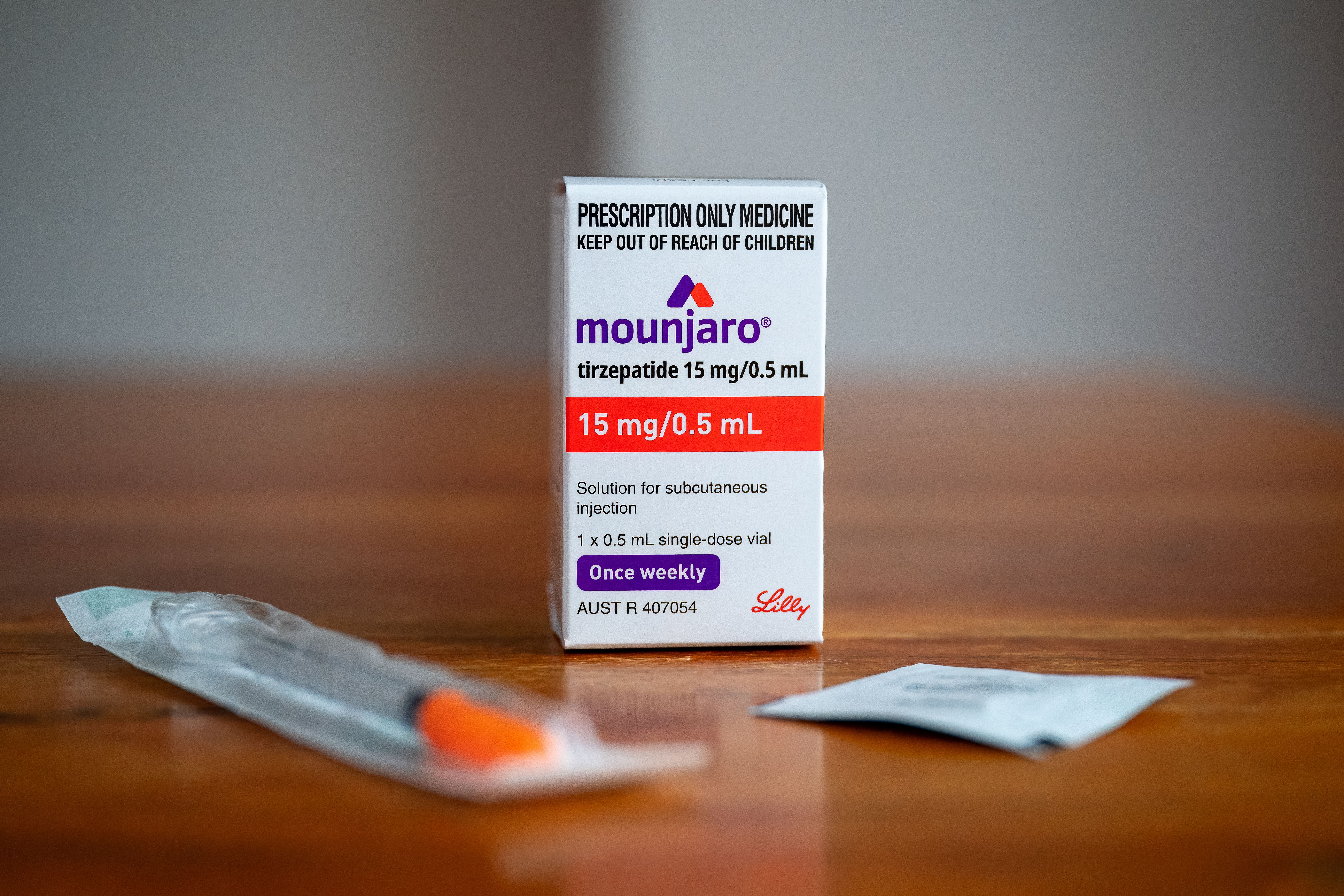News
Article
AHA 2024: Tirzepatide Lowers Risk of Worsening Heart Failure, CVD Death in Adults With Obesity
Author(s):
Key Takeaways
- Tirzepatide reduced the risk of worsening heart failure and cardiovascular events in HFpEF patients with obesity by 46% compared to placebo.
- Participants on tirzepatide experienced significant weight loss, improved health status, and increased exercise tolerance over two years.
This is the first trial that tested the effect of any medication on major heart failure outcomes in patients with HFpEF and obesity, according to investigators.
Editor's Note: This article was updated at 4:30pm on November 16, 2024.
New research findings from the SUMMIT trial presented at the American Heart Association (AHA) 2024 Scientific Sessions demonstrate that participants with heart failure with preserved ejection fraction (HFpEF) and obesity who took tirzepatide (Mounjaro, Zepbound; Lilly) for an average of 2 years had reduced combined risk of worsening heart failure events and cardiovascular events, as well as improved health status and functional capacity compared with the placebo group.1
Mounjaro medication box | Image credit: © Cynthia | stock.adobe.com

Tirzepatide is a long-acting agonist of glucose-dependent insulinotropic polypeptide (GIP) and glucagon-like peptide-1 (GLP-1) receptors. It has been FDA-approved for the treatment of type 2 diabetes for weight management in individuals with overweight or obesity. Notably, earlier research of tirzepatide has confirmed 12% to 21% weight loss in patients with obesity taking tirzepatide.1
“Obesity contributes to worsening heart failure, and while tirzepatide causes considerable weight loss, research is lacking on its effects on cardiovascular outcomes,” said lead study author Milton Packer, MD, a distinguished scholar in cardiovascular science at Baylor University Medical Center in Dallas and a visiting professor at Imperial College in London, in a news release. “This is the first trial that tested the effect of any medication on major heart failure outcomes in patients with HFpEF and obesity.”1
Study Design
In an in-depth session discussing the results of the SUMMIT trial, presenter Milton Packer, MD, discussed the interesting hypotheses and trial design.
Packer said obesity is not only one of the causes, but is in fact the cause of most cases of HFpEF. He and his colleagues put forth a proposed conceptual framework for this link, in which obesity leads to expansion and biological transformation of visceral fat. In turn, this causes altered synthesis of adipocytokines. The antinatiuretic effects of this cause sodium retention and plasma volume expansion, while the proinflammatory effects cause myocardial injury and fibrosis. These, in turn, cause the filling of the left ventrical and decreased ability of the left ventricle to tolerate filling, leading to HFpEF.2
"When you have the 2 working together, left ventricular filling pressures increase, particularly during exercise, and that is the syndrome of HFpEF," Packer said. "It starts as a biological neuroendocrine disorder, and it ends as a hemodynamic disorder."
Participants in the trial were required to have diagnosed HFpEF as well as 3 enrichment criteria: a 6-minute walk distance between 100 and 423 meters, a Kansas City Cardiomyopathy Questionnaire Clinical Summary Score (KCC-QCSS) of 80 or higher, and heart failure decompensation within 12 months or an estimated glomerular filtration rate (eGFR) greater than 70 mL/min/1.73m2. Packer said these enrichment criteria were specifically designed to identify patients at high risk of events, and patients had to fulfill all 3 in order to be included.2
Interestingly, Packer said the trial began as an events trial. Initially, the primary end point included worsening heart failure events in a hierarchical fashion to be analyzed. The researchers' original projections were 10% annual rate of event, 20% to 30% reduction of worsening heart failure, and no effect on cardiovascular death.2
This design changed, however, with the announcement of the STEP-HFpEF trial results with semaglutide in August of 2023, which showed an effect on worsening heart failure events with a hazard ratio (HR) of 0.08 and a 92% reduction in risk based on just 13 events.1
"When I saw that, I got incredibly excited," Packer said. "And through a wonderful series of discussions with the sponsor, with a very compelling reason, we decided to take events—cardiovascular death and worsening heart failure events—and take it out of the composite and have it as a standalone end point."
Packer added that worsening heart failure events were adjudicated by a blinded end point committee and defined as worsening symptoms of heart failure requiring either hospitalization, urgent intravenous drug therapy, or oral diuretic intensification.2
In the trial, 731 patients were included (364 in the tirzepatide arm and 367 in the placebo arm). Packer said this was an incredibly interesting patient population for multiple reasons. Firstly, the majority were women, which has not necessarily been the case in HFpEF research. Participants also had an average body mass index (BMI) of 38 and were markedly impaired based on eGFR, KCCQ-CSS, 6-minute walk, and heart failure decompensation scores. Based on these characteristics, 15.3% would be expected to experience a worsening heart failure event over a period of 1 to 3 years, or 8.8 events per 100 patient-years.
"We actually achieved the target population we were looking for," Packer said.
Results
In findings from the phase 3 SURMOUNT-1 trial (NCT04184622), the percentage of patients who lost more than 20% of their body weight was over 50% in the tirzepatide 10-mg and 15-mg groups, compared with just 3% in the placebo group. Because obesity is a major risk factor for the development of type 2 diabetes and cardiovascular diseases, reduced body weight is significant.3
Additionally, tirzepatide has shown significant promise in reducing liver fat content compared with insulin degludec in a subpopulation of patients with type 2 diabetes in the SURPASS-3 study.4 The impact of tirzepatide in individuals with nonalcoholic steatohepatitis will be assessed in the ongoing SYNERGY-NASH trial (NCT0416673).5
The new findings, from the international SUMMIT trial, include a total of 731 adults aged 40 years and older who had been diagnosed with HFpEF and obesity at health centers in 9 countries, including the US. All participants had ejection fraction of 50% or more and all had body mass index (BMI) measurements of 30 kg/m2 or higher.1
Participants were randomly assigned in nearly equal numbers to either the tirzepatide or placebo arms and received a weekly injection. The weekly dose was gradually titrated from 2.5 mg to a potential maximum dose of 15 mg per week, and all participants continued taking their regular medications, including those for heart failure, while enrolled in the study.1
With a median follow-up of 2 years and a maximum of 3 years, investigators found that cardiovascular death or worsening heart failure events occurred in 36 patients (9.9%) of the tirzepatide group, compared with 56 patients (15.3%) in the placebo group. Worsening heart failure events occurred in 29 patients (8%) of the tirzepatide group versus 52 patients (14.2%) in the placebo group, representing a 46% reduction in risk for individuals taking tirzepatide.1
There were 15 total cardiovascular deaths among both groups, 11 of which were not preceded by worsening heart failure. Two deaths in the tirzepatide group occurred after patients had not taken the medication for more than 15 months.1
At 1 year of follow-up, KCCQ-CSS scores were improved by an average of 6.9 points more in the tirzepatide group compared with the placebo group, suggesting participants perceived greater improvements in health and function with tirzepatide. Additionally, participants had 11.9% greater weight loss in the tirzepatide group compared with the placebo group, measured at 1 year.1
Participants in the tirzepatide group also improved their 6-minute walking distance test at 1 year by an average of 18.3 meters further, compared with the placebo group. Finally, individuals in the tirzepatide group had less systemic inflammation, based on a high-sensitivity C-reactive protein measure. When compared with placebo, on average, the difference in the percent changes in the tirzepatide group was 32.9%, indicating lower levels of inflammation.1
“These results indicate tirzepatide produced meaningful benefits for people living with heart failure with preserved ejection fraction and obesity,” Packer said. “The patients experienced a lower combined risk of worsening heart failure events and cardiovascular disease death, along with improved health status and exercise tolerance. This is the first trial to demonstrate that a medication can change the clinical trajectory of the disease in patients with HFpEF and obesity.”1
Packer acknowledged that there was no effect on all-cause mortality (HR 1.25, 0.63-2.45), saying that there has never been a HFpEF treatment that has shown impact on mortality function.2
"There's something different about mortality and HFpEF in patients with obesity," he said.
In subgroup analyses, tirzepatide reduced worsening heart failure events in every single group. Importantly, data were also promising for patients who were simultaneously taking other medications such as mineralocorticoid receptor agonists (MRAs) and sodium-glucose cotransporter-2 (SGLT2) medications.2
"We think that these drugs are all compatible with each other and likely to be added in," Packer said. "We're continuing to look at this. It's really, really interesting."
Additionally, Packer noted that the cumulative incidence curves appeared to be essentially overlapping for the first 4 months or so, until the peak dose of tirzepatide was reached at 20 weeks.2
"There is the impression that the time course of the effect on events is not really following the time course of the effect on body weight, but may be tracking with the time course of effects on inflammation," Packer said. "And that would be consistent with the [proposed conceptual framework] that I presented in the beginning."
Conclusion
Adverse effects are a common challenge for patients receiving tirzepatide and other similar GLP-1 medications, particularly gastrointestinal (GI) symptoms. Packer said discontinuation due to GI events is more common in the community setting, but may be less prevalent in clinical trials, where patients have more support and resources.2
In the SUMMIT trial, 4% of participants in the tirzepatide arm discontinued treatment due to GI events. Packer pointed out that 20% of patients discontinued treatment for any reason.2
Importantly, researchers noted that the use of BMI to measure body size is a limitation. Individuals with HFpEF often have a higher-than-normal waist-to-height ratio, suggesting visceral adiposity or high belly fat, with a BMI lower than 30 kg/m2, which does not meet the criteria for an obesity diagnosis. Further research should clarify the most accurate parameters for individuals who can benefit from treatment.1
REFERENCES
1. Tirzepatide lowered risk of worsening heart failure and CVD death for obese adults. News release. American Heart Association. November 16, 2024. Accessed November 16, 2024. https://newsroom.heart.org/news/tirzepatide-lowered-risk-of-worsening-heart-failure-and-cvd-death-for-obese-adults
2. Packer M. In-Depth: SUMMIT: Tirzepatide for Patients With Heart Failure With Preserved Ejection Fraction and Obesity. Presented at: American Heart Association Scientific Sessions 2024. November 16, 2024.
3. Jastreboff AM, Aronne LJ, Ahmad NN, et al. Tirzepatide once weekly for the treatment of obesity. New Eng J Med. 2022;387:205-216. doi:10.1056/NEJMoa2206038
4. Ludvik B, Giorgino F, Jódar E, et al. Once-weekly tirzepatide versus once-daily insulin degludec as add-on to metformin with or without SGLT2 inhibitors in patients with type 2 diabetes (SURPASS-3): a randomized, open-label, parallel-group, phase 3 trial. Lancet. 2021;398(10300):583-598. doi:10.1016/S0140-6736(21)01443-4
5. Loomba R, Hartman ML, Lawitz EJ, et al. Tirzepatide for metabolic dysfunction–associated steatohepatitis with liver fibrosis. N Engl J Med. 2024;391:299-310. doi:10.1056/NEJMoa2401943
Newsletter
Stay informed on drug updates, treatment guidelines, and pharmacy practice trends—subscribe to Pharmacy Times for weekly clinical insights.






